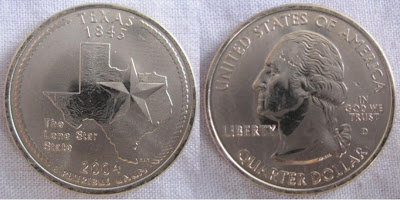Vermont state quarter
 The Vermont quarter features Camel's Hump Mountain with an image of maple trees with sap buckets in the forefront.
The Vermont quarter features Camel's Hump Mountain with an image of maple trees with sap buckets in the forefront.The design honors the "Green Mountain State," the first state admitted to the Union after the original 13 colonies. Vermont is most famous for its skiing and the production of maple sugar and syrup. Until the 1800s when cane sugar was introduced, Americans relied on Vermont's maple sugar for much of its sugar supply. Also featured on the quarter is Camel's Hump Mountain in the northern half of Vermont's Green Mountains. Camel's Hump is easily recognized by its unique double-humped profile and is one of the highest peaks in Vermont.
Utah state quarter
 The reverse of Utah's quarter features two locomotives moving toward the golden spike that joined the Central Pacific and Union Pacific railroads, linking East to West and transforming both the Utah Territory and the Nation with the inscription "Crossroads of the West."
The reverse of Utah's quarter features two locomotives moving toward the golden spike that joined the Central Pacific and Union Pacific railroads, linking East to West and transforming both the Utah Territory and the Nation with the inscription "Crossroads of the West."On May 10, 1869, two steam locomotives met at Promontory, Utah, for the "Joining of the Rails Ceremony," at which the Union Pacific and Central Pacific railroads completed the transcontinental route. The event was crucial to the development of the American West because it made cross-country travel more convenient and economical. The construction of the railroad, and the subsequent mining boom, brought diverse ethnic and religious populations to Utah. The railroad also symbolized the changing technology, and moved Utah from an agrarian economy to a more industrialized one.
Even before the time of steam locomotives, Utah experienced a steady flow of explorers and pioneers. The Spaniards first came to explore Utah in the 18th century and were followed by mountain men, Mormons and prospectors in search of precious metals found in the 1860s. Because of its central location, Utah became known as the "Crossroads of the West."
Texas state quarter
 The Texas quarter's reverse design incorporates an outline of the State with a star superimposed on the outline and the inscription, "The Lone Star State." The lariat encircling the design is symbolic of the cattle and cowboy history of Texas, as well as the frontier spirit that tamed the land.
The Texas quarter's reverse design incorporates an outline of the State with a star superimposed on the outline and the inscription, "The Lone Star State." The lariat encircling the design is symbolic of the cattle and cowboy history of Texas, as well as the frontier spirit that tamed the land.Texas comes from the Indian word "tejas," meaning friends or allies, and appropriately Texas's motto is "Friendship." Probably the two most recognized symbols of Texas are its unique shape and the lone star that is represented on the State flag. The Texas flag design was approved in 1839 to symbolize the Republic of Texas and was adopted as the State flag in 1845. The simple design of a lone star and three bold stripes of red, white and blue represent bravery, purity and loyalty, respectively. Texas is the only state to have had six different flags fly over its land; Spain, France, Mexico, Republic of Texas, Confederate States of America and the United States of America.



No comments:
Post a Comment